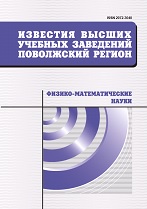|
|
University proceedings. Volga region. Physical and mathematical sciences, 2014, Issue 2, Pages 73–87
(Mi ivpnz350)
|
 |
|
 |
Physics
Energy properties of twin grain boundaries in the FeCr alloy: molecular statics simulation
M. Yu. Tikhoncheva, A. B. Muralevb, V. V. Svetukhina
a Research Technological Institute named after S. P. Kapitsa of Ulyanovsk State University, Ulyanovsk
b Ulyanovsk State University, Ulyanovsk
Abstract:
Background. Knowledge of the structure and energy characteristics of the grain boundaries (GB - grain boundary) is important for understanding such phenomena as grain growth , grain-boundary diffusion , segregation of impurities , deformation and destruction, which occur in materials. It is important to note the role of GB in radiation damage of materials. GBs are commonly considered as the sinks for point defects and impurity atoms. However, detailed studies of these mechanisms at the atomic level have been started only recently. The aim of the work is to obtain quantitative estimates which characterize the energy properties of twin grain boundaries in $\alpha$-Fe containing chromium. Materials and methods. The simulation was performed using the molecular statics method. To describe the interatomic interaction the authors used a modified version of multiparticle potential, offered by A. Caro and others. This potential well-reproduces the curve of mixing enthalpy of random ferromagnetic FeCr alloy. Results. The specific energies were evaluated for five grain boundaries: $\sum$ 5(210), $\sum$ 5(310), $\sum$ 17(410), $\sum$ 13(510) and $\sum$ 17(530) with one rotation axis [001]. The sizes of the corresponding grain boundary regions in pure iron at zero temperature and in the binary Fe- 9at. $\%$ Cr alloy at temperatures between 0 and 300 K were obtained. The binding energies of the vacancy, self-interstitial atom (SIA) and substitutional Cr atom to the GB in pure Fe were estimated. Two SIAs configurations were considered. These configurations were <110> Fe-Fe and <110> Fe-Cr dumbbells. Conclusions. Satisfactory agreement between the obtained results and the results of other researchers were observed for pure iron at zero temperature. Fe-9at. $\%$ Cr alloy was found to demonstrate the specific energy higher by 0.1 J/m2 than that of pure Fe. With rising temperature up to 300K the GB specific energy decreases by 0.1 - 0.2 J/m2. The GB region width is 1 nm for all GBs and it varies slightly with composition and temperature. In most cases, the sharp changes of binding energy with increasing distance to the GB were observed. In the case of a vacancy or substitutional atom, these changes occur with a change of sign. High positive binding energy ( 3 eV) of the SIAs of both considered configurations was registered for all GB types. Attraction of a vacancy to the GB region is also assumed as energetically favorable (the binding energy is 0.3 - 1eV). These results explain the property of the grain boundary region to accumulate point defects during material radiation damage process which were observed in the numerical experiments performed by different researchers. At that, accumulation of self interstitial atoms is more intense due to its high binding energy and high mobility.
Keywords:
grain boundary, formation energy, binding energy, molecular statics method.
Citation:
M. Yu. Tikhonchev, A. B. Muralev, V. V. Svetukhin, “Energy properties of twin grain boundaries in the FeCr alloy: molecular statics simulation”, University proceedings. Volga region. Physical and mathematical sciences, 2014, no. 2, 73–87
Linking options:
https://www.mathnet.ru/eng/ivpnz350 https://www.mathnet.ru/eng/ivpnz/y2014/i2/p73
|

| Statistics & downloads: |
| Abstract page: | 30 | | Full-text PDF : | 10 | | References: | 12 |
|




 Contact us:
Contact us: Terms of Use
Terms of Use
 Registration to the website
Registration to the website Logotypes
Logotypes








 Citation in format
Citation in format 